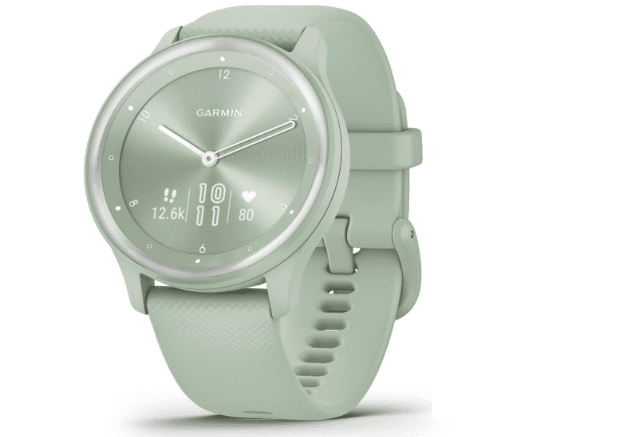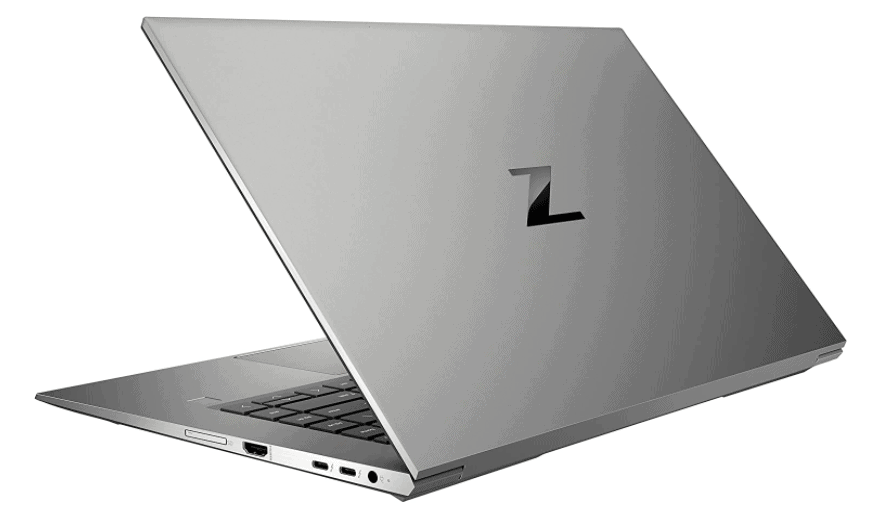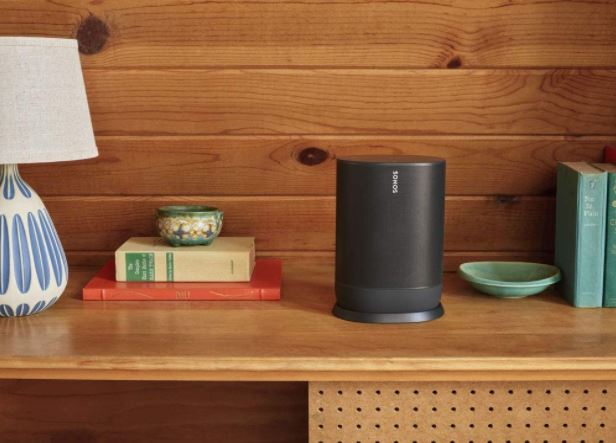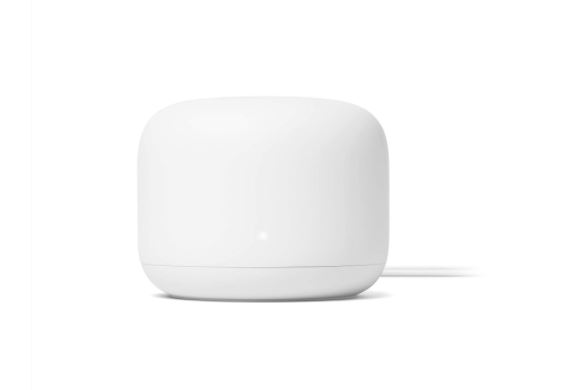The new Asus Zenbook S 13 OLED seems contemporary in every way. It’s one of the first laptops to use AMD’s new Ryzen 6000 CPUs, and it has a 16:10 OLED display. Asus has also shrunk the chassis from the previous Zenbook S UX393 model to make it even sleeker and trim.
I examined the one configuration that Asus will offer in the United States in June 2022, which will cost $1,300. It came with a Ryzen 7 6800U, 16GB of DDR5 RAM, a 1TB PCIe 4.0 solid-state drive (SSD), and an OLED display. That’s an attractive price for such a well-configured premium laptop, and there’s a lot of power packed inside the thin and light chassis with a gorgeous display that’s bright and colorful with inky blacks.
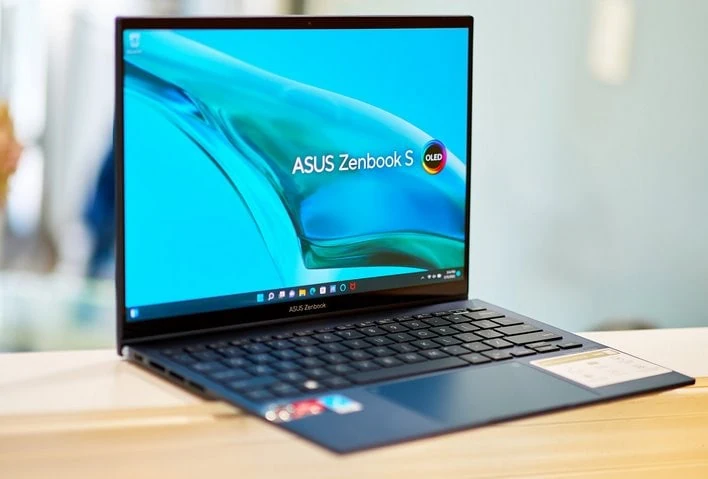
Asus Zenbook S 13 OLED Design
The lid of the Zenbook S 13 OLED features the new stylized Asus logo, which I enjoy despite its resemblance to the Star Trek insignia. It does not, however, like the concentric circle motif that adorns so many other Zenbooks. Its lid is a matte “Ponder Blue” instead, a dark blue color that looks black in certain lighting. Only the new chrome bar that connects to the chrome hinges and runs along the back of the chassis adds any glitter to the laptop’s color scheme. The Zenbook S 13 OLED has a conservative appearance due to its simple and streamlined lines.
The Zenbook appears quite minimalist in comparison to its main competitor, the Dell XPS 13, with its white or black fiber keyboard deck and sleek silver aluminum chassis. In comparison to the Lenovo ThinkBook 13x, with its basic silver exterior, the Zenbook appears opulent. In either case, it’s a pleasing appearance.
The Zenbook S 13 OLED’s chassis is made of a magnesium-aluminum alloy, which adds to the laptop’s light weight of 2.2 pounds. While that is a strong alloy, the Zenbook’s lid was bendable with applied effort, and the keyboard deck flexed somewhat. It’s nothing major, though, and the laptop seems solid overall.
The XPS 13 is 2.8 pounds heavier, but it has a more sturdy structure with no bending, flexing, or twisting. The Zenbook S 13 OLED is somewhat thicker than the XPS 13, measuring 0.59 inches vs 0.58 inches.
The XPS 13 is somewhat less deep than the Zenbook due to its thinner display bezels all around and greater than 90 percent screen-to-body ratio, whereas has an 89 percent screen-to-body ratio due to a little wider bottom chin. However, they are both small laptops that are easy to transport.
The hinge on the Zenbook S 13 OLED is tight, needing two hands to open, yet it prevents shaking when working. It’s not as fluid as the XPS 13’s dual-clutch hinge, which gives the Dell a more assured feel.
It’s not unexpected that connectivity is limited in such a small gadget. There are three USB-C 3.2 Gen 2 ports and a 3.5mm audio connector. The latter is an upgrade over the previous generation Zenbook S, which lacked an audio connector. With Wi-Fi 6E and Bluetooth 5.2, wireless connectivity is completely up to date.
You may also like Lenovo Legion 5 Pro Gaming Laptop
Asus Zenbook S 13 OLED Display
The Zenbook S 13 OLED features a 13.3-inch 16:10 OLED 2.8K (2,880 x 1,800) display that runs at 60Hz. It’s a stunning screen right out of the box, with vivid colors and deep blacks that are typical of OLED panels.
My colorimeter confirmed this. The brightness of the OLED panel was 366 nits, which was higher than our 300-nit benchmark but not as bright as the other displays in our comparison group. Colors were saturated at 100 percent sRGB, 96 percent AdobeRGB, and 100 percent DCI-P3, and they were also accurate, with a DeltaE of 1.0. (1.0 or less is considered excellent). The contrast was high, as expected from an OLED display, at 25,560:1.
The display on the Zenbook S 13 OLED is more than adequate for demanding artists and a joy to use for productivity and media consumption. Thanks to DisplayHDR 500 and Dolby Vision compatibility, high dynamic range (HDR) content popped with loads of detail in darker environments. Simply, it’s a beautiful display that provides an outstanding computing experience.
Audio
Two speakers situated beneath the front of the chassis produce audio, which is powered by a smart amplifier that adjusts the sound to the speakers’ capabilities. I expected greater volume from such a compact laptop, with crisp mids and highs and even some bass. The sound quality amazed me, and you can easily binge-watch Netflix and listen to music without using headphones or an additional speaker.
You may also like AMD Ryzen 6000 CPU: The Performance Punch Processor
Asus Zenbook S 13 OLED Performance
AMD has just released the first Ryzen 6000 series chips, and the Zenbook S 13 OLED is one of the first to be equipped with the 8-core/16-thread Ryzen 7 6800U. The Ryzen 7 6800H is the lower-powered version of the chip, with a configurable TDP ranging from 15 to 28 watts. The Ryzen 7 6800U is a great CPU for such a small and light notebook, and it delivers good performance.
That’s exactly what the processor delivered, according to our tests. It performed poorly in Geekbench 5, trailing Intel’s 28-watt, 12-core, 16-thread 12th-generation Core i7-1260P. In mainstream laptops, this is the major competitor for the Ryzen 7 6800U. I’m not clear why the processor performed so poorly in this test, coming in only 19% faster than the Ryzen 7 5800U.
Fortunately, it performed admirably in our Handbrake test, encoding a 420MB video as H.265. It finished in 112 seconds, faster than the Lenovo Yoga 9i 14 Gen 7 in balanced mode but slower in performance mode, and slightly faster than the Samsung Galaxy Book 2 Pro, which also used the Core i7-1260P. Cinebench R23, it was competitive with the Intel chip in multi-core mode but considerably slower in single-core mode. Except for the Lenovo ThinkBook 13X with its low-power 11th-generation Core i5, all of the comparison machines performed equally well in the PCMark 10 Complete benchmark, which measures performance across multiple works, entertainment, and creativity applications.
I’ll mention that the Zenbook S 13 OLED comes with a utility for fine-tuning performance with Whisper, Balanced, and Performance modes. The benchmark results in the table were obtained in Balanced mode, but there was little difference in the Performance mode. I monitored the CPU’s temperature in both modes, and while Balanced mode kept things cool enough to run Cinebench R23 to avoid throttling, Performance mode almost instantly caused the CPU to hit its maximum operating temperature of 95 degrees C and throttle.
This brings up an important point about these results. The Zenbook S 13 OLED is a very thin laptop that does not have space for a complex thermal design or large fans. As a result, the Ryzen 7 6800U may outperform a thicker laptop with better thermals. As is, it’s a quick chip for productivity that can do some creative activities in a pinch, which is impressive given a laptop the size of the Zenbook.
In this case, the AMD Radeon 680M, and the Ryzen 6000 series include faster integrated AMD Radeon graphics based on the RDNA 2 architecture. The integrated graphics outperformed the Ryzen 7 5800U in the 3DMark Time Spy benchmark, and it outperformed the fastest Intel Iris Xe graphics in our comparison group.
The Zenbook S 13 OLED achieved 33 frames per second (fps) at 1200p with high graphics and 19 fps with epic graphics enabled in Fortnite. This is a few frames per second faster than laptops with Intel’s Iris Xe graphics and a significant improvement over the Ryzen 7 5800U’s integrated Radeon graphics. The Zenbook isn’t a gaming machine, but it’s at least playable at 1200p with decent graphics in a title like Fortnite, especially if you drop settings down a bit more.
You may also like Best Acer Chromebook Deals to Buy
The Battery Life
Asus crammed a 67-watt-hour battery inside the Zenbook S 13 OLED, which is a lot for a 13-inch laptop. In comparison, the Dell XPS 13 has only 52 watt-hours. But because we’re dealing with a brand-new CPU, I wasn’t sure what to expect in terms of battery life. I knew the power-hungry OLED display would have an influence, but I was curious how long the laptop would survive on a single charge.
Unfortunately, it failed to complete the PCMark 10 Applications or Gaming battery tests, leaving us without the best indicator of productivity performance or power consumption while on charge. That’s unfortunate, but the Zenbook isn’t the only laptop I’ve evaluated that struggled with these tests.
The Zenbook S 13 OLED lasted just over eight hours on our web browsing test, which cycles through a couple of prominent and difficult websites. This is somewhat below average and places it below the 14-inch laptops with high-resolution IPS panels and the Core i7-1260P in our comparison. In our video test, which plays a local Full HD Avengers trailer for around 13.25 hours, the Zenbook won the group. The discrepancy between the two tests could be explained by the darker scenes in the video using less display power than the whiter web pages.
Overall, battery life was poor, and it’s uncertain whether the laptop would survive a full day on a single charge. You may need to transport your charger, which is fortunately light and compact.
webcam
The webcam is Full HD, which is nice to see, and it includes 3D noise-reduction technology, which Asus claims reduces up to 94 percent of the random noise that can degrade image quality. The webcam produced a superb image even in low-light circumstances, making it a perfect choice for hybrid workers who rely on videoconferencing to communicate with colleagues.
Asus Zenbook S 13 OLED Keyboard
The Asus ErgoSense keyboard occupies a significant amount of the deck, providing adequate keycap size and key spacing, as well as indented keys for added comfort. The switches have 1.4mm of travel, a light but clicky feel, and precise bottoming action. It’s a comfortable keyboard for lengthy typing sessions, and it’s on par with the top keyboards in Dell’s XPS and HP’s Spectre lineups in terms of quality.
You may also like ASUS ROG Flow X13 Gaming Laptop
Touchpad
A fingerprint reader incorporated in the power button, the ideal place, supports Windows Hello passwordless login. During my testing, it was quick and dependable.
The touchpad is huge and takes up the majority of the available palm rest space. Swiping and performing Windows 11 multitouch gestures are smooth and precise thanks to Microsoft Precision touchpad drivers, and the buttons are sturdy with a little loud click. Asus coated the touchpad with a hydrophobic (water-repelling) and anti-fingerprint coating to assist keep it clean, last longer due to wear and tear resistance and deliver greater feedback.
The touchpad includes the Asus NumberPad 2.0, which activates an LED numeric keypad, which is beneficial for anyone who enters a lot of numbers. It is simple to turn on and off, and while turned on, it does not interfere with typical touchpad use. The display in my evaluation device was touch-enabled, and it was as precise and snappy as usual.
Would you like to read more about Asus Zenbook S 13 OLED-related articles? If so, we invite you to take a look at our other tech topics before you leave!







